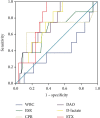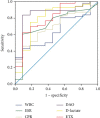The Correlation between Endotoxin, D-Lactate, and Diamine Oxidase with Endoscopic Activity in Inflammatory Bowel Disease
- PMID: 36157220
- PMCID: PMC9507744
- DOI: 10.1155/2022/9171436
The Correlation between Endotoxin, D-Lactate, and Diamine Oxidase with Endoscopic Activity in Inflammatory Bowel Disease
Abstract
Methods: A total of 149 eligible IBD patients including 82 Crohn disease (CD) and 67 Ulcerative colitis (UC) who had received both endoscopic examination and intestinal barrier function detection in our hospital were enrolled in this study. Endoscopic activity was estimated by the Simple Endoscopic Score (SES-CD) for Crohn's Disease and the ulcerative colitis endoscopic index of severity (UCEIS) for ulcerative colitis. The predictive value and optimal predictive thresholds for those biomarkers were determined by receiver operating characteristic analysis.
Results: For UC patients, DAO, D-lactate, and ETX showed better correlation with UCEIS than erythrocyte sedimentation rate (ESR) and C-reactive protein (CRP) and exhibited satisfactory predictive value in predicting remission. Among patients with CD, DAO and ETX not only showed a better correlation than WBC, ESR, and CRP with SES-CD but also capable to identify more severe patients.
Conclusion: DAO and ETX could be used to distinguish different endoscopic activity of CD. DAO, D-lactate, and ETX could predict UC endoscopic remission.
Copyright © 2022 Qi Zhang et al.
Conflict of interest statement
The authors declare no conflicts of interest.
Figures






Similar articles
-
Platelet/Albumin ratio and plateletcrit levels are potential new biomarkers for assessing endoscopic inflammatory bowel disease severity.BMC Gastroenterol. 2023 Nov 14;23(1):393. doi: 10.1186/s12876-023-03043-4. BMC Gastroenterol. 2023. PMID: 37964205 Free PMC article.
-
Efficacy of noninvasive evaluations in monitoring inflammatory bowel disease activity: A prospective study in China.World J Gastroenterol. 2017 Dec 14;23(46):8235-8247. doi: 10.3748/wjg.v23.i46.8235. World J Gastroenterol. 2017. PMID: 29290660 Free PMC article.
-
Fecal Calprotectin Thresholds to Predict Endoscopic Remission Using Advanced Optical Enhancement Techniques and Histological Remission in IBD Patients.Inflamm Bowel Dis. 2021 Apr 15;27(5):647-654. doi: 10.1093/ibd/izaa163. Inflamm Bowel Dis. 2021. PMID: 32592477
-
Inter- and Intraobserver Variability on Endoscopic Scoring Systems in Crohn's Disease and Ulcerative Colitis: A Systematic Review and Meta-Analysis.Inflamm Bowel Dis. 2024 Nov 4;30(11):2217-2226. doi: 10.1093/ibd/izae051. Inflamm Bowel Dis. 2024. PMID: 38547325
-
Definition and evaluation of mucosal healing in clinical practice.Dig Liver Dis. 2013 Dec;45(12):969-77. doi: 10.1016/j.dld.2013.06.010. Epub 2013 Aug 7. Dig Liver Dis. 2013. PMID: 23932331 Review.
Cited by
-
Hesperidin Helps Improve the Intestinal Structure, Maintain Barrier Function, and Reduce Inflammation in Yellow-Feathered Broilers Exposed to High Temperatures.Animals (Basel). 2024 Sep 5;14(17):2585. doi: 10.3390/ani14172585. Animals (Basel). 2024. PMID: 39272369 Free PMC article.
-
Dietary Supplementation of Ancientino Ameliorates Dextran Sodium Sulfate-Induced Colitis by Improving Intestinal Barrier Function and Reducing Inflammation and Oxidative Stress.Nutrients. 2023 Jun 19;15(12):2798. doi: 10.3390/nu15122798. Nutrients. 2023. PMID: 37375702 Free PMC article.
-
N-(3-Oxododecanoyl)-Homoserine Lactone Induces Intestinal Barrier Damage in Piglets via the Lipid Raft-Mediated Apoptosis Pathway.Vet Sci. 2025 Mar 3;12(3):233. doi: 10.3390/vetsci12030233. Vet Sci. 2025. PMID: 40266950 Free PMC article.
-
Nomogram-based risk prediction model employing serum biomarkers to assess intestinal injury risk in patients with metabolic syndrome.Front Endocrinol (Lausanne). 2025 Jun 16;16:1579833. doi: 10.3389/fendo.2025.1579833. eCollection 2025. Front Endocrinol (Lausanne). 2025. PMID: 40589515 Free PMC article.
-
Feeding Intolerance-A Key Factor in the Management of Acute Pancreatitis: A Review.J Clin Med. 2024 Oct 24;13(21):6361. doi: 10.3390/jcm13216361. J Clin Med. 2024. PMID: 39518500 Free PMC article. Review.
References
-
- Niederau C., Backmerhoff F., Schumacher B., Niederau C. Inflammatory mediators and acute phase proteins in patients with Crohn’s disease and ulcerative colitis. Hepato-Gastroenterology . 1997;44(13):90–107. - PubMed
-
- Yoon J. Y., Park S. J., Hong S. P., Kim T. I., Kim W. H., Cheon J. H. Correlations of C-reactive protein levels and erythrocyte sedimentation rates with endoscopic activity indices in patients with ulcerative colitis. Digestive Diseases and Sciences . 2014;59(4):829–837. doi: 10.1007/s10620-013-2907-3. - DOI - PubMed
MeSH terms
Substances
LinkOut - more resources
Full Text Sources
Medical
Research Materials
Miscellaneous

